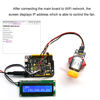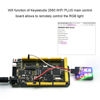Keyestudio ESP8266 WIFI MEGA-2560 MCU &ATMEGA328 UNOPlus Development Board +Type-C USB Compatible With Arduino Mega/UNOR3
WIFI ATMEGA328 UNOPlus main control board adopts two MCU including ATMEGA328 and esp8266, containing all functions of Arduino unoR3 and ESP8266development board.
The download function of the serial port is controlled by the toggle switch, and the codes of the two MCU can be burned separately by using a USB interface so that two development boards can be used alone or combined. It is very convenient when using. Esp8266+Arduino UNO is suitable for the development of the Internet of Things, networking functions, and independent wireless network construction.
Parameters
Working Voltage: USB/5V
DC/6-9V (Esp8266/3.3V; ATmega328P/5V)
Current: Maximum output 3.3V/800mA、5V/800mA
Maximum Power: 4W
Working Temperature Range :-10~50°C
Dimensions: 68.5*53.5*13mm
Environmental Attributes: ROHS
ATmega328
Digital I/O Pin :14pin (6 for PWM output)
ATmega328 PWM Digital I/O: 6pin
ATmega328 Analog Input Pin: 8pin (A4,A5 as regular I2C)
DC of each ATmega328
I/O Pin :20mA
ATmega328 flash :32KB (ATmega328P), 0.5KB used for bootloader)
ATmega328 SRAM: 2KB(ATmega328P)
ATmega328 EEPROM:1KB(ATmega328P)
ATmega328 Clock Speed :16MHZ
Esp8266 Digital I/O Pin :9 on-board pins
Esp8266 PWM Digital I/O: 4pin(IO4, IO12, IO14, IO15)
DC of each Esp8266 I/O Pin :20mA
Esp8266 flash:2Mb
Esp8266 SRAM:50kb
Esp8266Clock Speed:26MHZ
Esp8266Radio Frequency:2.4GHZ Receiver and Transmitter
Wifi :ESP8266EX supports TCP/IP protocol and 802.11 b/g/n WLAN MAC protocol.
Supports Basic Service Set (BSS) STA and SoftAP operation under Distributed Control Function (DCF).
Enables optimization of active hours by minimizing host interaction for power management.
For more details, please refer to the following link
//fs.keyestudio.com/KS5013





 Keyestudio 2560 WIFI PLUS Main Control Board adopts two MCU including ATmega 2560 and esp8266, containing all functions of Arduino Mega 2560and ESP8266 development board. The two MCU combination is suitable for the development of the Internet of Things, networking functions, and independent wireless network construction.
Keyestudio 2560 WIFI PLUS Main Control Board adopts two MCU including ATmega 2560 and esp8266, containing all functions of Arduino Mega 2560and ESP8266 development board. The two MCU combination is suitable for the development of the Internet of Things, networking functions, and independent wireless network construction.
The download function of the serial port is controlled by the toggle switch, and the codes of the two MCU can be burned separately by using a USB interface so that two development boards can be used alone or combined. It is very convenient when using.
Parameters
Working Voltage:USB/5V; DC/6-9V (Esp8266/3.3V; ATmega 2560/5V)
Working Current:Maximum output 3.3V/800mA or 5V/1.6A
Maximum Power:8W
Working Temperature Range :-10~50 °C
Dimensions:103*53.5*13mm
Environmental Attributes:ROHS
ATmega 2560 Digital I/O:54 pin (15 for PWM output; D20,D21 as regular I2C)
ATmega 2560 PWM Digital I/O:15 pin
ATmega 2560 Analog Input Pin:16 pin
DC of each ATmega 2560 I/O Pin:20mA
ATmega 2560 flash:256KB(8KB used for bootloader)
ATmega 2560 SRAM :8KB
ATmega 2560 EEPROM:4KB
ATmega 2560Clock Speed :16MHZ
Esp8266 Digital I/O:9 on-board pin
Esp8266 PWMDigital I/O:4 pin (IO4,IO12,IO14,IO15)
DC of each Esp8266 I/O Pin :20mA
Esp8266 flash:2Mb
Esp8266 SRAM:50kb
Esp8266Clock Speed:26MHZ
Esp8266Radio Frequency:2.4GHZ Receiver and Transmitter
Wifi :ESP8266EX supports TCP/IP protocol and 802.11 b/g/n WLAN MAC protocol.
Supports Basic Service Set (BSS) STA and SoftAP operation under Distributed Control Function (DCF).
Enables optimization of active hours by minimizing host interaction for power management.
For more details, please refer to the following link
//fs.keyestudio.com/KS5014



































